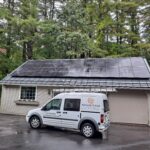Through the landmark tax legislation that passed at the end of 2010, the federal government was able to extend the Section 1603 Treasury Grant program for renewable energy commercial projects, including solar photovoltaic, through December 31, 2011. Section 1603 establishes that businesses eligible for the federal business energy investment tax credit (ITC) may take a cash grant instead of the ITC.
The American Recovery and Reinvestment Act, enacted in July 2009, created the Section 1603 tax grant program. The Solar Energy Industries Association (SEIA) has credited Section 1603 with prompting over 1,100 solar installations in 42 states and creating 100% growth in solar investments in 2010. The increased solar capacity is supplying power to 200,000 homes and providing jobs for approximately 93,000 individuals.
Commercial entities that own renewable energy projects that start construction in 2009, 2010, or 2010 and are completed by the deadline (2012 for wind, 2016 for solar and fuel cell, and 2013 for all other renewables) will qualify for a tax incentive equal to 30% of the project’s cost with no cap. The incentive may be taken in the form of a tax credit (ITC) or cash grant. The advantage of a tax grant is payment must be made within 60 days from the later of the date when the property is placed into service or the date of the application. With a tax credit, you will have to wait to capitalize on the incentive until you file your taxes the following year.
The Department of Treasury has detailed information on their website as to the terms of Section 1603. In order to request a cash grant in lieu of the business ITC, you must complete the online application and attach necessary documents.
Documentation is required to prove that:
(1) The property is eligible – an engineering diagram stamped by a PE is compulsory for all properties.
(2) The property has been placed in to service – for interconnected systems, the approval from the utility to interconnect is required.
(3) The amount requested is accurate – a breakdown of all costs that make up the cost basis are required.
For more information about the Section 1603 federal tax grant for commercial solar installations, please refer to the Department of Treasury.
Brightstar Solar is a licensed solar installer servicing Massachusetts and Connecticut. We work with our customers to help navigate the installation process and maximize incentives. If you have a home or business in Massachusetts or Connecticut and are interested in solar power, please contact us for a free evaluation.








Pingback: Tweets that mention Federal Grant Explained for Commercial Solar — BRIGHTSTAR SOLAR -- Topsy.com
Pingback: Depreciation Benefits for Commercial Solar Installations — BRIGHTSTAR SOLAR
Pingback: US Solar Installed Capacity Sees Fastest Growth in 2010 — BRIGHTSTAR SOLAR
Pingback: Depreciation Benefits for Commercial Solar Installations
Pingback: Explained: Federal Grants for Commercial Solar